Satas D., Tracton A.A. (ed.). Coatings Technology Handbook
Подождите немного. Документ загружается.

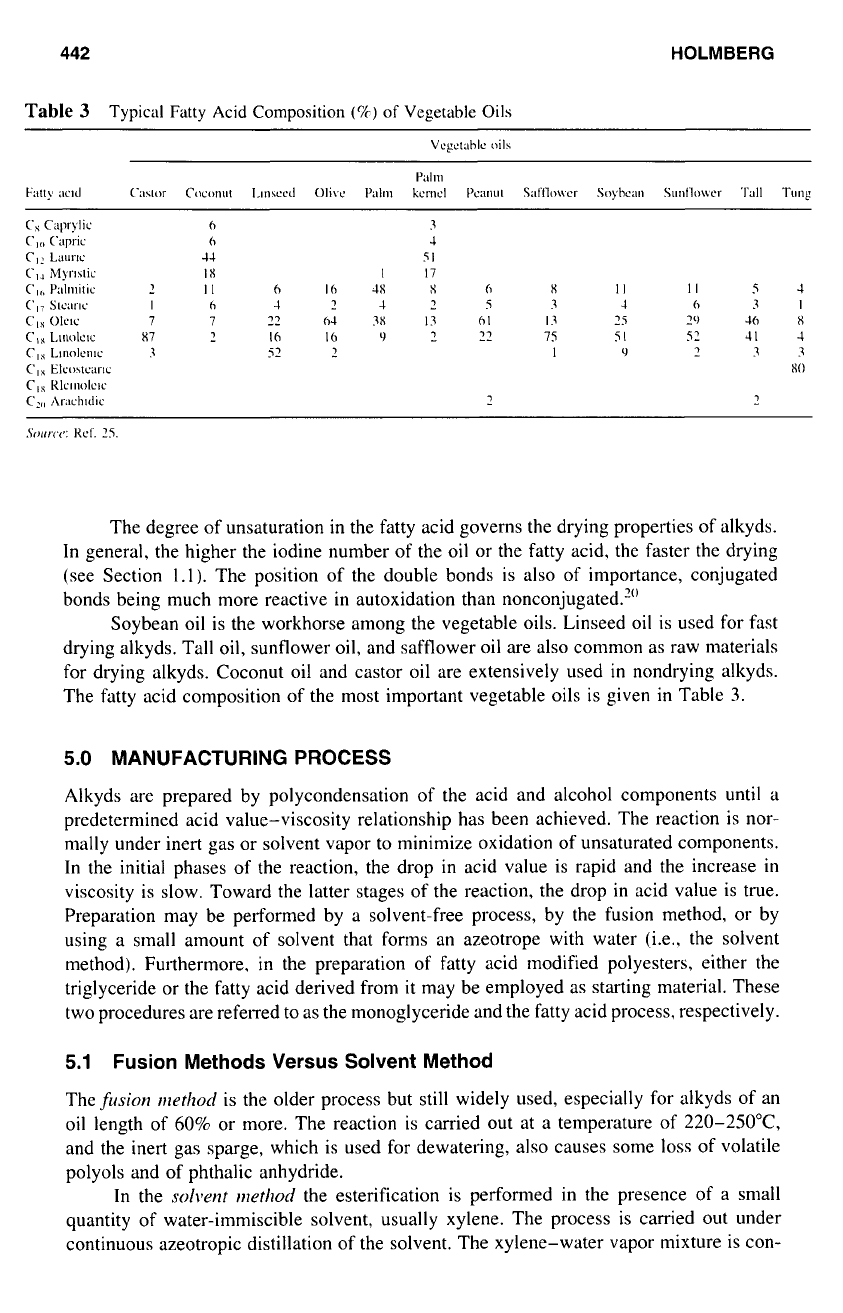
442
HOLMBERG
Table
3
Typical Fatty
Acid
Composition
(%)
of
Vegetable Oils
The degree of unsaturation in the fatty acid governs the drying properties of alkyds.
In general, the higher the iodine number of the
oil
or the fatty acid, the faster the drying
(see Section
1.1).
The position of the double bonds is also
of
importance, conjugated
bonds being much more reactive in autoxidation than nonconjugated.'"
Soybean oil is the workhorse among the vegetable oils. Linseed oil is used for fast
drying alkyds. Tall oil, sunflower
oil,
and safflower oil are also common as raw materials
for drying alkyds. Coconut oil and castor oil are extensively used in nondrying alkyds.
The fatty acid composition of the most important vegetable oils is given in Table
3.
5.0
MANUFACTURING PROCESS
Alkyds are prepared by polycondensation of the acid and alcohol components until a
predetermined acid value-viscosity relationship has been achieved. The reaction is nor-
mally under inert gas or solvent vapor
to
minimize oxidation of unsaturated components.
In the initial phases
of
the reaction, the drop
in
acid value is rapid and the increase in
viscosity is slow. Toward the latter stages
of
the reaction, the drop
in
acid value is true.
Preparation may be performed by a solvent-free process, by the fusion method, or by
using a small amount of solvent that forms an azeotrope with water (i.e.. the solvent
method). Furthermore.
in
the preparation of fatty acid modified polyesters, either the
triglyceride or the fatty acid derived from it may be employed as starting material. These
two procedures are referred
to
as the monoglyceride and the fatty acid process, respectively.
5.1
Fusion Methods Versus Solvent Method
The
fusion
method is the older process but still widely used, especially for alkyds of an
oil length
of
60%
or more. The reaction is carried out at a temperature
of
22O-25O0C,
and the inert gas sparge, which is used for dewatering, also causes some
loss
of volatile
polyols and
of
phthalic anhydride.
In the
solvent
rnerhoci the esterification is performed in the presence of a small
quantity of water-immiscible solvent, usually xylene. The process is carried out under
continuous azeotropic distillation
of
the solvent. The xylene-water vapor mixture is con-
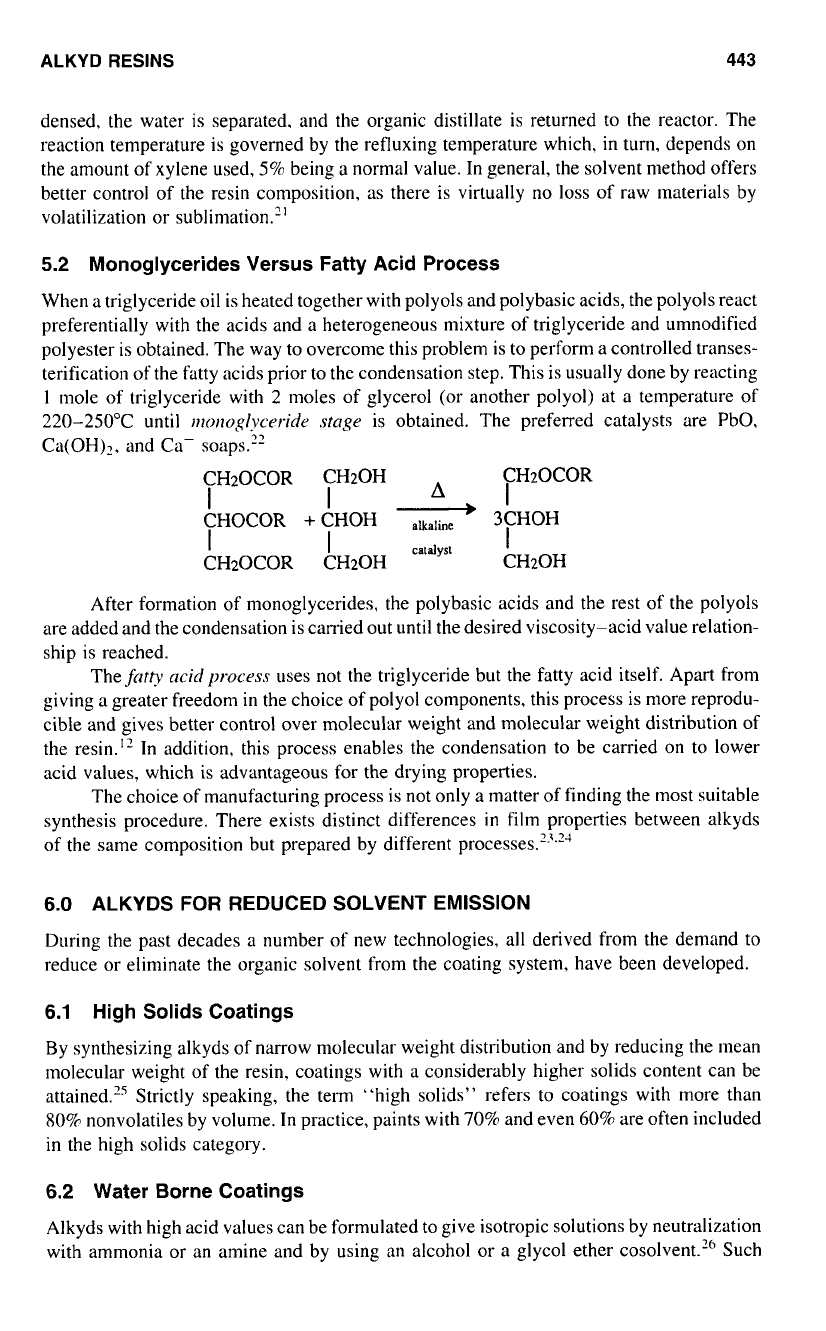
ALKYD
RESINS
443
densed, the water is separated. and the organic distillate is returned
to
the reactor. The
reaction temperature is governed by the refluxing temperature which, in turn, depends on
the amount
of
xylene used,
5%
being
a
normal value. In general, the solvent method offers
better control of the resin composition, as there is virtually no
loss
of raw materials by
volatilization or sublimation.”
5.2
Monoglycerides Versus Fatty Acid Process
When a triglyceride oil is heated together with polyols and polybasic acids, the polyols react
preferentially with the acids and a heterogeneous mixture of triglyceride and umnodified
polyester is obtained. The way to overcome this problem is
to
perform
a
controlled transes-
terification
of
the fatty acids prior to the condensation step. This is usually done by reacting
1
mole
of
triglyceride with
2
moles of glycerol (or another polyol) at a temperature of
220-250°C
until
motzoglyceride
stage
is obtained. The preferred catalysts are PbO.
Ca(OH),, and Ca- soaps.”
CH20COR CH20H
CHOCOR +CHOH
e
3CHOH
CH20COR CH20H CH20H
I
I
A
CH20COR
I
I
I
catalyst
I
After formation of monoglycerides, the polybasic acids and the rest
of
the polyols
are added and the condensation is carried out until the desired viscosity-acid value relation-
ship is reached.
The
fhtty
acid
process
uses not the triglyceride but the fatty acid itself. Apart from
giving
a
greater freedom
in
the choice of polyol components, this process is more reprodu-
cible and gives better control over molecular weight and molecular weight distribution of
the resin.”
In
addition, this process enables the condensation to be carried on to lower
acid values. which is advantageous for the drying properties.
The choice of manufacturing process is not only
a
matter of finding the most suitable
synthesis procedure. There exists distinct differences
in
film properties between alkyds
of the same composition but prepared by different processes.23.74
6.0
ALKYDS FOR REDUCED SOLVENT EMISSION
During the past decades a number
of
new technologies, all derived from the demand to
reduce or eliminate the organic solvent from the coating system, have been developed.
6.1
High Solids Coatings
By
synthesizing alkyds of narrow molecular weight distribution and by reducing the mean
molecular weight of the resin. coatings with a considerably higher solids content can be
attained.” Strictly speaking, the term “high solids” refers to coatings with more than
80%
nonvolatiles by volume.
In
practice, paints with 70% and even 60% are often included
in the high solids category.
6.2
Water Borne Coatings
Alkyds with high acid values can be formulated to give isotropic solutions by neutralization
with ammonia
or
an amine and by using an alcohol or a glycol ether cosolvent.76 Such
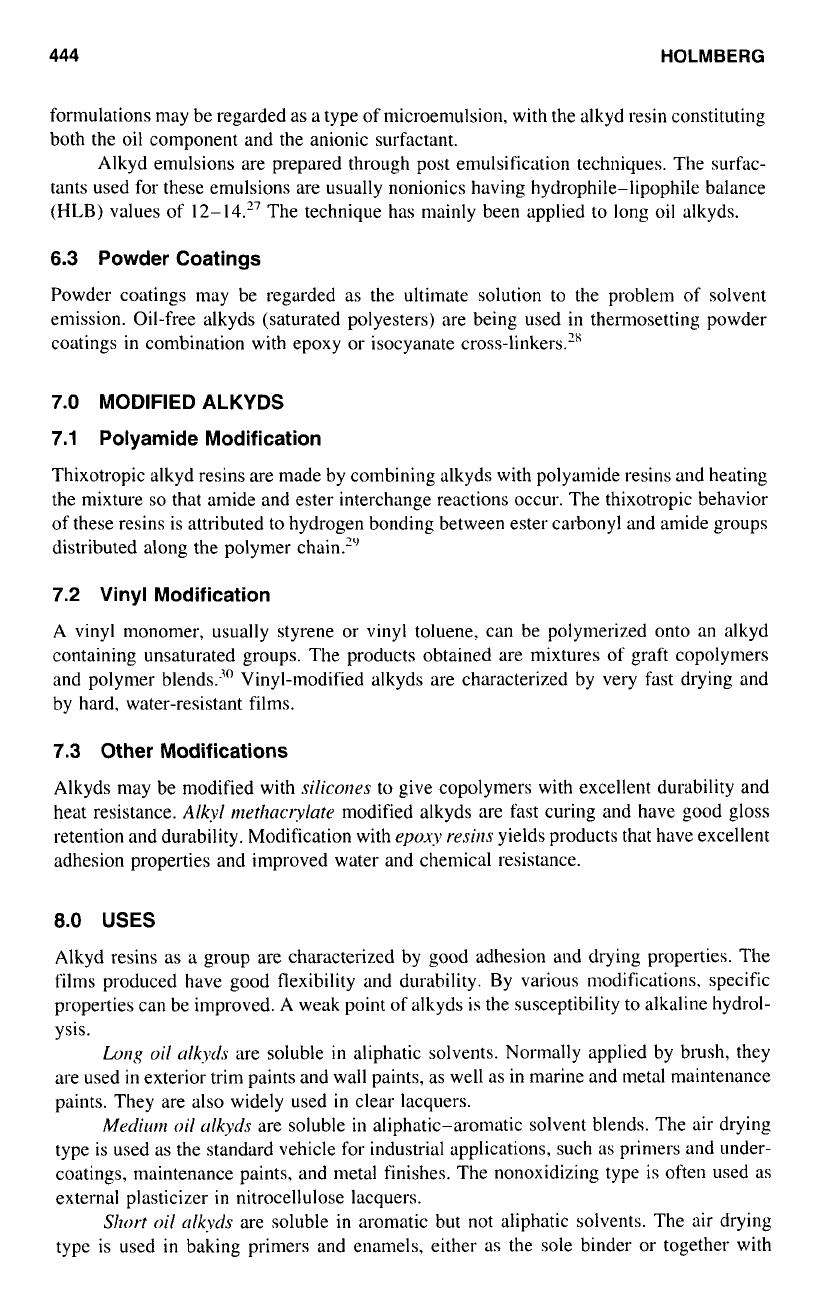
444
HOLMBERG
formulations may be regarded as a type of microemulsion, with the alkyd resin constituting
both the oil component and the anionic surfactant.
Alkyd emulsions are prepared through post emulsification techniques. The surfac-
tants used for these emulsions are usually nonionics having hydrophile-lipophile balance
(HLB)
values of
12-14.”
The technique has mainly been applied to long
oil
alkyds.
6.3 Powder Coatings
Powder coatings may be regarded as the ultimate solution to the problem
of
solvent
emission. Oil-free alkyds (saturated polyesters) are being used in thermosetting powder
coatings in combination with epoxy or isocyanate cross-linkers.’s
7.0 MODIFIED ALKYDS
7.1 Polyamide Modification
Thixotropic alkyd resins are made by combining alkyds with polyamide resins and heating
the mixture
so
that amide and ester interchange reactions occur. The thixotropic behavior
of these resins is attributed to hydrogen bonding between ester carbonyl and amide groups
distributed along the polymer chain.’”
7.2
Vinyl Modification
A vinyl monomer, usually styrene or vinyl toluene. can be polymerized onto an alkyd
containing unsaturated groups. The products obtained are mixtures of graft copolymers
and polymer blends? Vinyl-modified alkyds are characterized by very fast drying and
by hard, water-resistant films.
7.3 Other Modifications
Alkyds may be modified with
silicones
to
give copolymers with excellent durability and
heat resistance.
Alkyl
methactylate
modified alkyds are fast curing and have good gloss
retention and durability. Modification with
epoxy
resirls
yields products that have excellent
adhesion properties and improved water and chenlical resistance.
8.0
USES
Alkyd resins as a group are characterized by good adhesion and drying properties. The
films produced have good flexibility and durability. By various modifications. specific
properties can be improved. A weak point of alkyds is the susceptibility to alkaline hydrol-
ysis.
Long
oil
alkycls
are soluble
in
aliphatic solvents. Normally applied by brush, they
are used
in
exterior trim paints and wall paints, as well as in marine and metal maintenance
paints. They are also widely used
in
clear lacquers.
Medilrrn
oil
alkyls
are soluble
in
aliphatic-aromatic solvent blends. The air drying
type is used as the standard vehicle for industrial applications, such as primers and under-
coatings, maintenance paints, and metal finishes. The nonoxidizing type is often used as
external plasticizer
in
nitrocellulose lacquers.
Slzort
oil
Nlkyds
are soluble in aromatic but
not
aliphatic solvents. The air drying
type is used
in
baking primers and enamels, either as the sole binder or together with
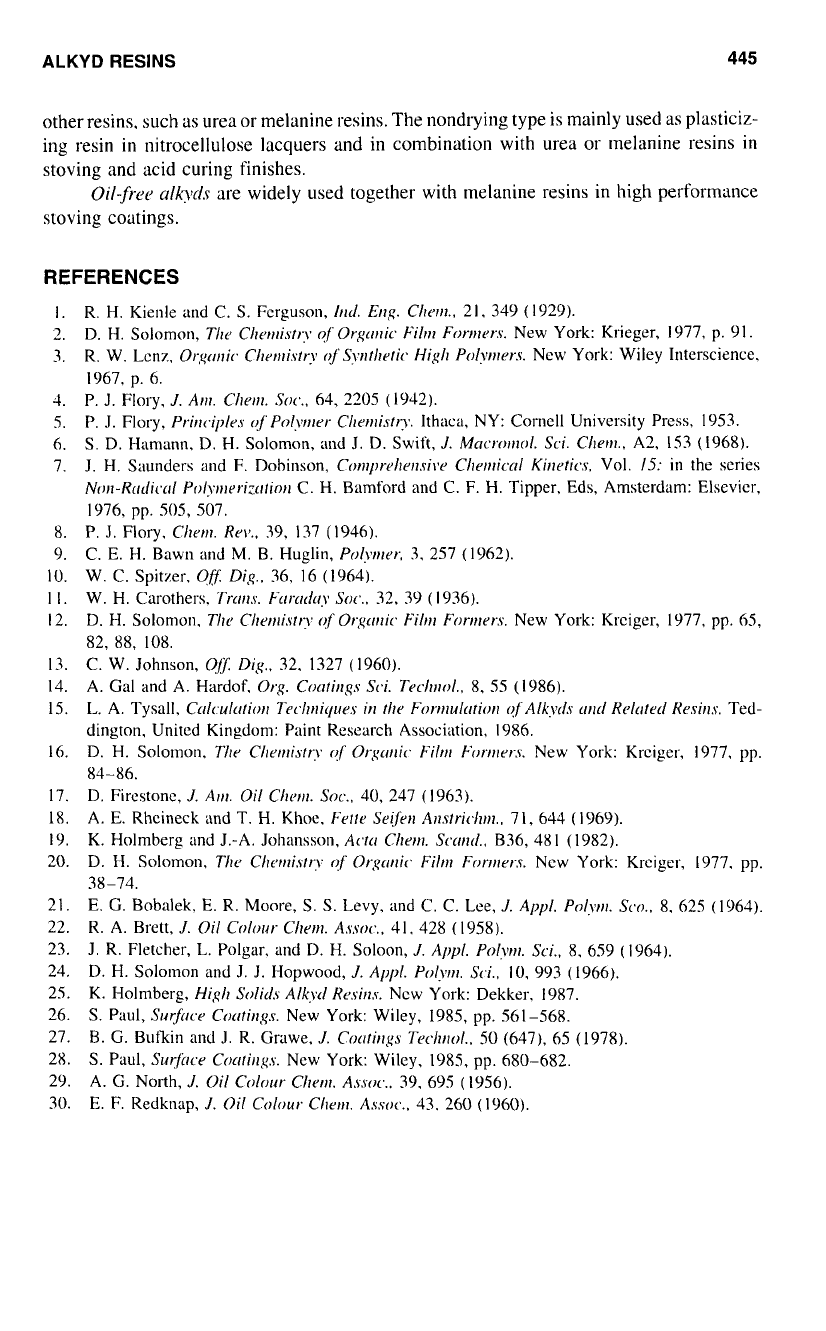
ALKYD
RESINS
445
other resins, such as urea or melanine resins. The nondrying type is mainly used as plasticiz-
ing resin
in
nitrocellulose lacquers and in combination with urea or melanine resins
in
stoving and acid curing finishes.
Oil,fr-er
ull0,cls
are widely used together with melanine resins in high performance
stoving coatings.
REFERENCES
I.
R. H. Kienle
and
C.
S.
Fcrguson,
Irrd.
Eug.
Clwrr~.,
21.
349
(
1929).
2.
D.
H.
Solomon,
Tlw
Cherrri.str;v
of
Orgtrrlic'
Film
Forrrwrs.
New York: Krieger, 1977, p.
9
1.
3.
R. W. Lcnz.
0r;q:ctrric
Cherr~istry
of'
Syrrthrric.
High
Po/ywr.s.
Ncw York: Wiley Intcrscience.
1.
P.
J. Flory,
J.
A~II.
Cherr~.
Soc.
..
64, 2205
(
1942).
S.
P. J. Flory,
Prirwiples
oj'Polyrwr
Clrmistr;v.
Ithacn, NY:
Corncll
University Press,
1953.
6. S.
D. Hamann.
D.
H. Solomon,
and
J.
D. Swift,
J.
Maclortwl.
Sci.
Chenf..
A2,
153
(1968).
7.
J.
H. Snunders and F. Dobinson,
Conl~,ru/rrrlsi~~~~
Cl~rrrricnl
Kirletics,
Vol.
15:
in
the scries
Nort-Rtrtlicul
Polyrlrrriztrtiorr
C.
H.
Bamford and C. F. H. Tipper, Eds, Amsterdam: Elsevicr,
1976, pp.
505,
507.
1967, p.
6.
8.
P.
J.
Flory.
Clzrtn.
Rev.,
39,
I37
(1946).
9.
C.
E.
H.
Bawn and
M.
B. Hugh,
folwer,
3.
257
(1962).
IO.
W. C. Spitzer,
Q8
Dig..
36,
16
(1964).
1
I.
W. H. Carothers,
Trtrrls.
Fc/rdcy
Soc..
32,
39
(
1936).
12.
D. H. Solomon.
The
Cl~errrisrr?
of
Orpu~ic
Fih
Forrrrers.
New York: Krciger, 1977, pp.
6s.
13.
C.
W.
Johnson,
Qjf:
Dig..
32.
1327
(
1960).
14. A. Gal and A. Hardof.
Org
Cocztirzgs
Sci.
Techno/..
8.
55
(1986).
15.
L.
A.
Tysall,
C~clcultrtiorr
TechrIique.s
in
the
Forrrlulotiorl
of
Alkyls
CUI(/
Keltrtrrl
Kesir~s.
Ted-
dington. United Kingdom: Paint Research Association, 1986.
16. D. H. Solornon.
The
C/wrr~istt:v
of
O,;yctrric
Filtrr
Forrrrcw.
New York: Krciger, 1977,
pp.
84-86.
17. D. Firestone,
J.
Aur.
Oil
Chcm
Soc.,
40,
247
(1963).
18.
A. E. Rhcineck
and
T. H. Khoe,
Fetre
Sejfrrr
All.s/ric/ltr~.,
71, 644
(1969).
19.
K.
Holmberg and J.-A. Johansson,
Actcc
Clrerrl.
Scccrztl..
B36, 48
I
(1982).
20.
D.
H.
Solomon,
The
C/~m~i,~/r;v
of
Or,qorric
Filrrl
Forrrlers.
New York: Krciger, 1977. pp.
21. E.
G.
Bobalek, E.
R.
Moore,
S.
S.
Levy.
and
C.
C. Lee,
J.
Appl.
P(J/~UI.
Sco.,
8.
625
(
1964).
22. R.
A.
Brett,
J.
Oil
Colour
Clterr~.
Assoc.,
41,
428
(
1958).
23.
.l.
R. Fletcher,
L.
Polgar.
and D. H. Soloon,
J.
Appl.
Polw.
Sci.,
8.
659
(
1964).
24. D.
H.
Solomon and
J.
J. Hopwood,
J.
Appl.
Polyrl.
S(i,
IO.
993
(1966).
25.
K. Holmberg,
Hi,gl~
Solids
Alkyl
Ke.sirzs.
Ncw York: Dekker. 1987.
26.
S.
Pnul,
Sur-fi~~
Cocctings.
New York: Wiley,
1985,
pp. 561-568.
27.
B.
G. Butkin
and
J.
R. Grawe,
J.
Cotrtir~~gs
Tdlrlol.,
50
(647),
65
(1978).
28.
S.
Paul,
Su@ce
Corrlirrp.
Ncw York: Wiley,
1985,
pp.
680-682.
29.
A.
G. North,
J.
Oil
Colour
ClIerrI.
Assoc~..
39. 695
(
1956).
30.
E. F. Redknap,
J.
Oil
Colour
Cherrl.
A.S.S(JC..
43.
260
(
1960).
82,
88,
108.
38-74.
This Page Intentionally Left Blank
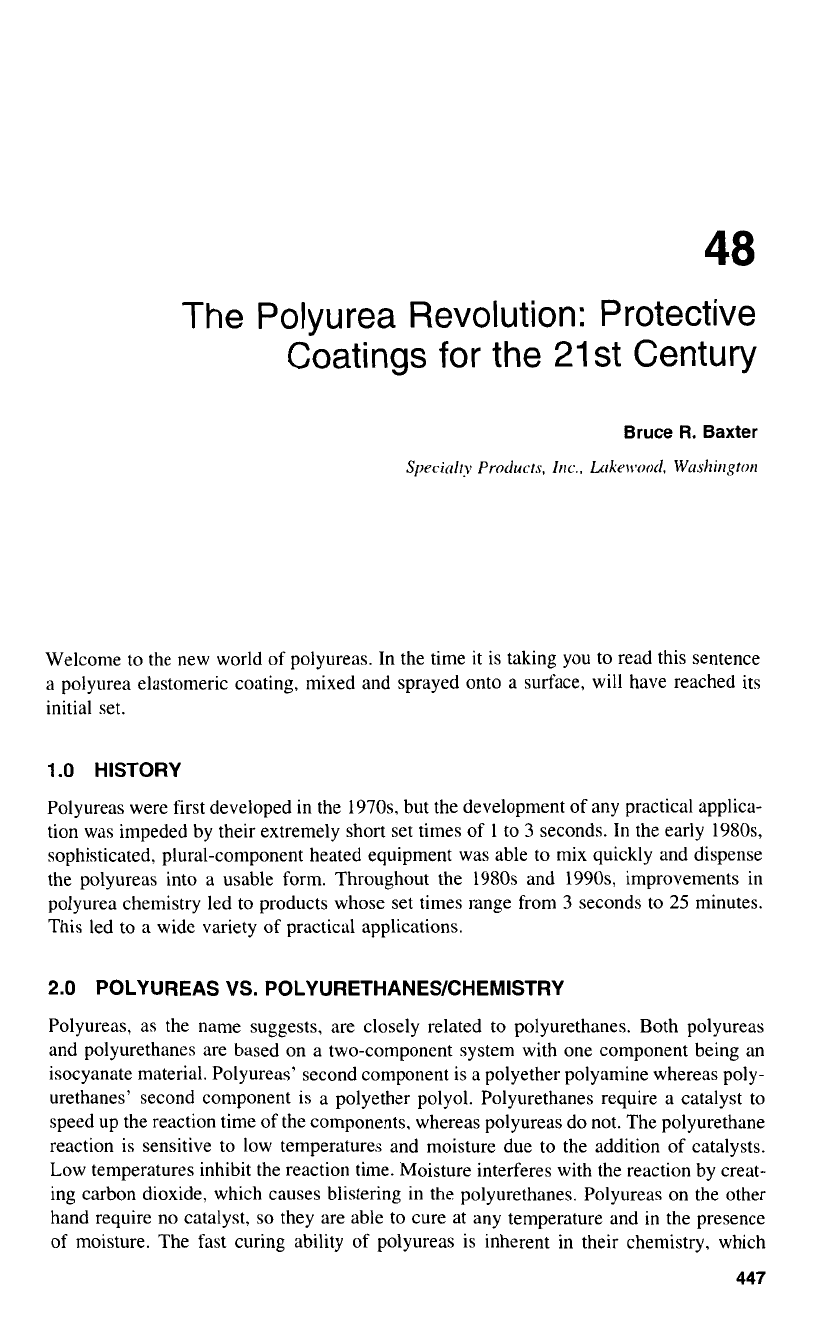
48
The Polyurea Revolution: Protective
Coatings for the 21st Century
Welcome to the new world of polyureas. In the time it is taking you to read this sentence
a polyurea elastomeric coating, mixed and sprayed onto a surface, will have reached its
initial set.
1
.O
HISTORY
Polyureas were first developed in the
1970s,
but the development of any practical applica-
tion was impeded by their extremely short set times
of
1
to
3
seconds. In the early
1980s,
sophisticated, plural-component heated equipment was able
to
mix quickly and dispense
the polyureas into a usable form. Throughout the
1980s
and
1990s,
improvements in
polyurea chemistry led
to
products whose set times range from
3
seconds
to
25
minutes.
This led to a wide variety of practical applications.
2.0
POLYUREAS
VS.
POLYURETHANESKHEMISTRY
Polyureas, as the name suggests, are closely related
to
polyurethanes. Both polyureas
and polyurethanes are based on a two-component system with one component being an
isocyanate material. Polyureas’ second component is a polyether polyamine whereas poly-
urethanes’ second component is a polyether polyol. Polyurethanes require a catalyst to
speed up the reaction time
of
the components, whereas polyureas do not. The polyurethane
reaction is sensitive to low temperatures and moisture due
to
the addition of catalysts.
Low temperatures inhibit the reaction time. Moisture interferes with the reaction by creat-
ing carbon dioxide, which causes blistering in the polyurethanes. Polyureas on the other
hand require no catalyst,
so
they are able
to
cure at any temperature and in the presence
of moisture. The fast curing ability of polyureas is inherent in their chemistry, which
447
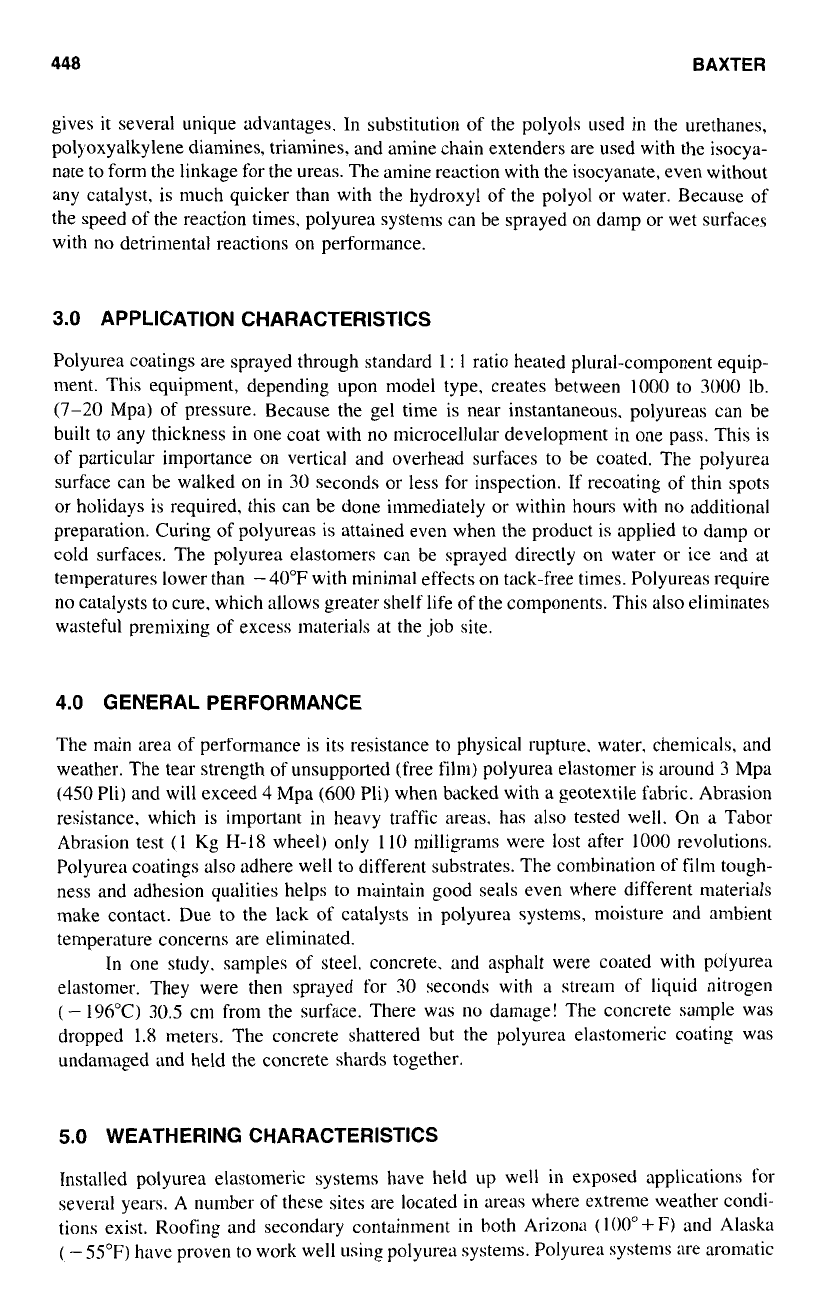
448
BAXTER
gives it several unique advantages. In substitution of the polyols used in the urethanes,
polyoxyalkylene diamines, triamines. and amine chain extenders are used with the isocya-
nate to form the linkage for the ureas. The amine reaction with the isocyanate, even without
any catalyst, is much quicker than with the hydroxyl of the polyol or water. Because of
the speed
of
the reaction times. polyurea systems can be sprayed on damp
or
wet surfaces
with
no
detrimental reactions
on
performance.
3.0
APPLICATION CHARACTERISTICS
Polyurea coatings are sprayed through standard
1
:
1
ratio heated plural-component equip-
ment. This equipment, depending upon model type, creates between
1000
to
3000
lb.
(7-20
Mpa) of pressure. Because the gel time is near instantaneous, polyureas can be
built to any thickness in one coat with no microcellular development in one pass. This is
of
particular importance on vertical and overhead surfaces
to
be coated. The polyurea
surface can be walked
on
in
30
seconds or less for inspection. If recoating of thin spots
or holidays is required, this can be done immediately or within hours with
no
additional
prepamtion. Curing
of
polyureas is attained even when the product is applied to damp or
cold surfaces. The polyurea elastomers can be sprayed directly
on
water or ice and at
temperatures lower than
-
40°F with minimal effects
on
tack-free times. Polyureas require
no catalysts to cure, which allows greater shelf life of the components. This also eliminates
wasteful premixing of excess materials at the job site.
4.0
GENERAL PERFORMANCE
The main area
of
performance is its resistance to physical rupture. water, chemicals, and
weather. The tear strength
of
unsupported (free film) polyurea elastomer is around
3
Mpa
(450 Pli) and will exceed
4
Mpa
(600
Pli) when backed with a geotextile fabric. Abrasion
resistance, which is important
in
heavy traffic areas. has
also
tested well. On a Tabor
Abrasion test
(I
Kg
H-l8
wheel) only
1
IO
milligrams were lost after
1000
revolutions.
Polyurea coatings also adhere well
to
different substrates. The combination of film tough-
ness and adhesion qualities helps to maintain good seals even where different materials
make contact. Due
to
the lack
of
catalysts in polyurea systems, moisture and ambient
temperature concerns are eliminated.
In one study. samples
of
steel, concrete. and asphalt were coated with polyurea
elastomer. They were then sprayed for
30
seconds with a stream
of
liquid nitrogen
(-
196°C)
30.5 cm from the surface. There was
no
damage! The concrete sample was
dropped
1.8
meters. The concrete shattered but the polyurea elastomeric coating was
undanlaged and held the concrete shards together.
5.0
WEATHERING CHARACTERISTICS
Installed polyurea elastomeric systems have held up well in exposed applications for
several years. A number of these sites are located in areas where extreme weather condi-
tions exist. Roofing and secondary containment in both Arizona
(100"
+F)
and Alaska
(
-
55°F)
have proven to work well using polyurea systems. Polyurea systems are aromatic
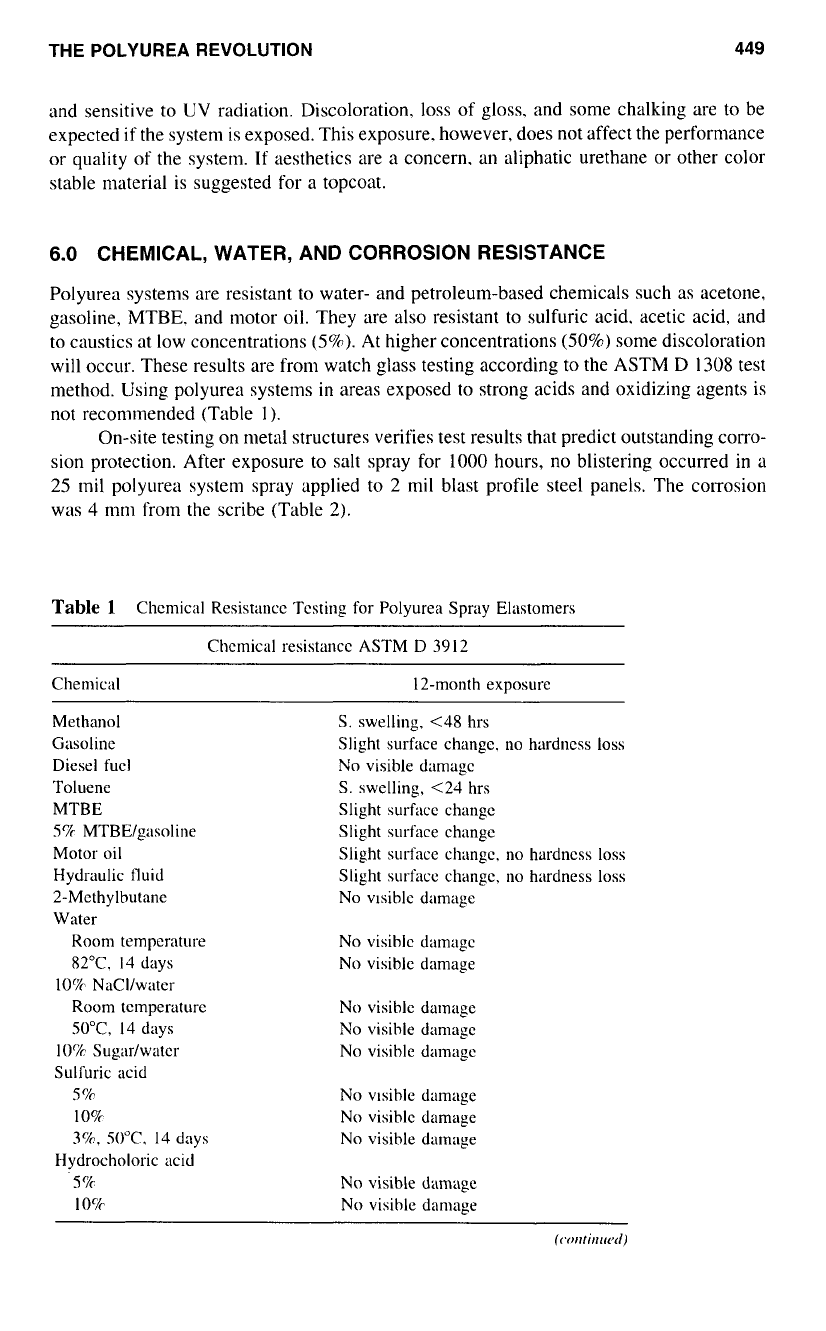
THE
POLYUREA
REVOLUTION 449
and sensitive to
UV
radiation. Discoloration,
loss
of
gloss. and some chalking are
to
be
expected
if
the system is exposed. This exposure. however, does not affect the performance
or quality of the system.
If
aesthetics are a concern, an aliphatic urethane or other color
stable material is suggested for a topcoat.
6.0
CHEMICAL, WATER, AND CORROSION RESISTANCE
Polyurea systems are resistant to water- and petroleum-based chemicals such as acetone,
gasoline, MTBE. and motor oil. They are also resistant to sulfuric acid, acetic acid, and
to caustics at low concentrations
(5%).
At higher concentrations
(50%)
some discoloration
will occur. These results are from watch glass testing according
to
the ASTM
D
1308
test
method. Using polyurea systems
in
areas exposed
to
strong acids and oxidizing agents is
not
recommended (Table
I
).
On-site testing on metal structures verifies test results that predict outstanding corro-
sion protection. After exposure
to
salt spray for
1000
hours, no blistering occurred
in
a
25
mil
polyurea system spray applied
to
2
mil blast profile steel panels. The corrosion
was
4
mm
from the scribe (Table
2).
Table
1
Chcmical Resistancc Tcsting
for
Polyurea Spray Elastomers
Chemical resistancc ASTM
D
3912
Chemical 12-month exposure
Methanol
S.
swelling,
<4X
hrs
Gasolinc Slight surface changc.
no
hardncss
loss
Diesel
fucl
No
visible damagc
Toluene
S.
swelling, <24 hrs
MTBE Slight
surfi~cc
changc
5%
MTBElgnsoline Slight
surface
changc
Motor oil Slight surface chnngc, no hardncss
loss
Hydraulic fluid Slight
surfacc
changc,
no
hardness
loss
2-Mcthylbutane No vlsible damage
Water
Room tempcrature
No
visihlc damngc
X2T,
14
days No visible damage
10%
NaCl/water
Room tcmperature
No visible datnage
SOT,
14
days
No
visihle dnmagc
10%
Sugar/watcr
No
visible dsmagc
Sulfuric acid
S
Yr
No
vtsihlc datnagc
3%.
SOT,
14
days
No visible damage
10%
No visihlc damage
Hydrocholoric acid
5%
No visible damagc
10%
No visible damage
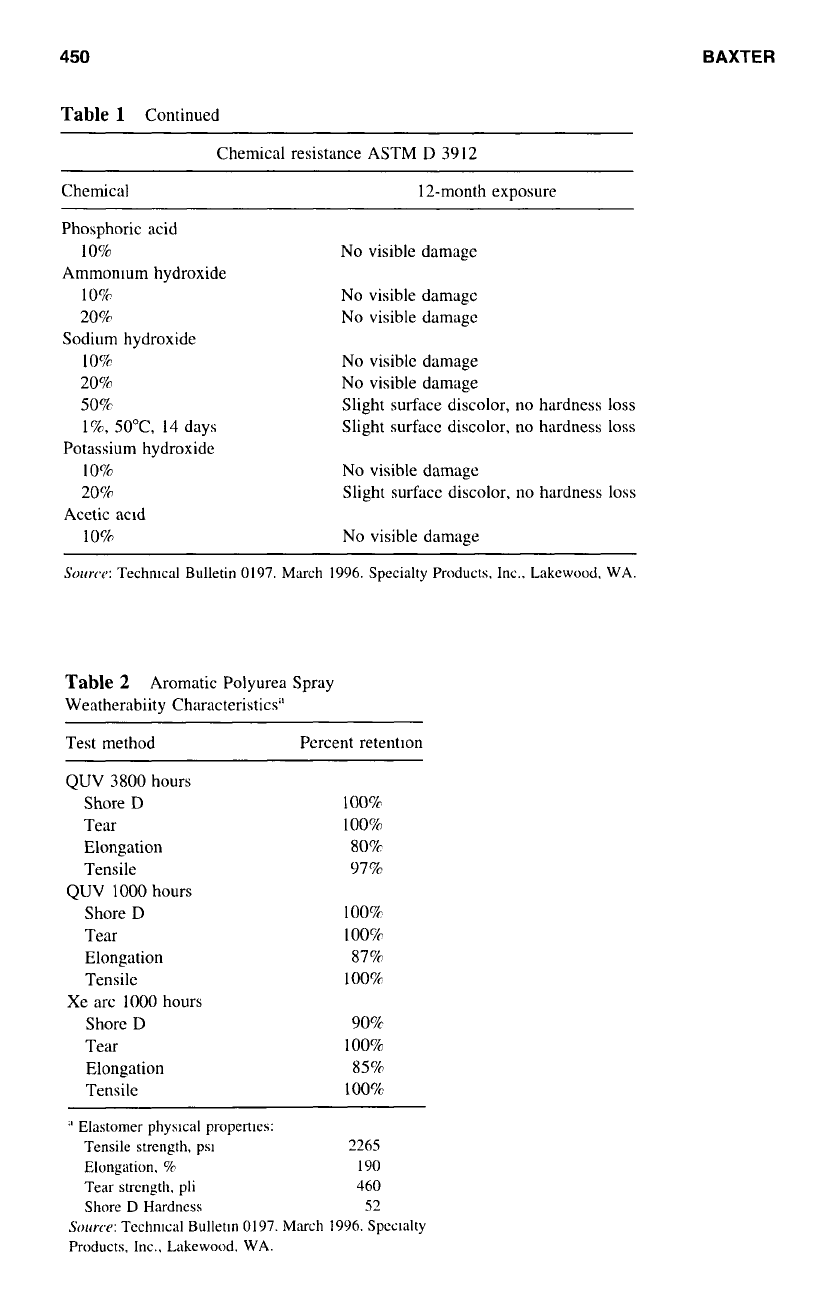
450
Table
1
Continued
BAXTER
Chemical resistance ASTM
D
3912
Chemical
1
"month exposure
Phosphoric acid
Ammonun hydroxide
10%
108
209
10%
20%
50%
l%,
50"C,
14
days
Potassium hydroxide
10%
208
10%
Sodium hydroxide
Acetic ac~d
No
visible damage
No
visible damagc
No
visible damage
No
visible damage
No
visible damage
Slight surface discolor, no hardness
loss
Slight surface discolor,
no
hardness
loss
No
visible damagc
Slight surface discolor.
no
hardness
loss
No
visible damage
Soltrcc.:
Technlcal Bulletin 0197. March 1996. Specialty Products. Inc.. Lakewood.
WA.
Table
2
Aromatic Polyurea Spray
Weatherabiity Characteristics"
Test method Percent retentlon
QUV
3800
hours
Shore
D
Tear
Elongation
Tensile
QUV
1000
hours
Shore
D
Tear
Elongation
Tensile
Xe arc
1000
hours
Shore
D
Tear
Elongation
Tensile
100%
100%
80%
977c
100%
100%
87%
100%
90%
100%
85%
100%
Elastomer physical properties:
Tensile strength,
PSI
2265
Elongation.
c/c
I90
Tear strength.
pli
460
Shore
D
Hardness 52
Sourcc
Technlcal Bulletm 0197. March 1996.
Specialty
Products, Inc.. Lakewood.
WA.
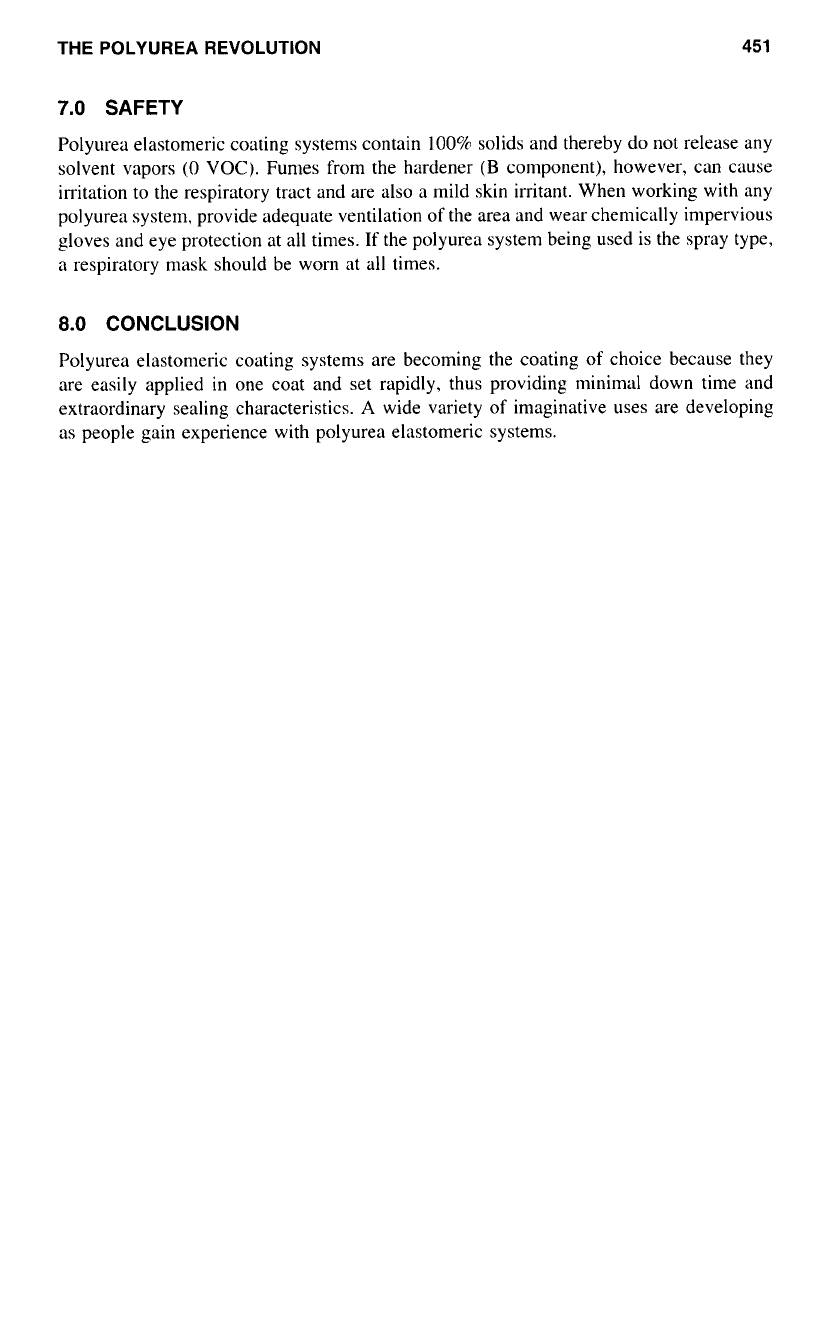
THE
POLYUREA
REVOLUTION
451
7.0
SAFETY
Polyurea elastomeric coating systems contain
100%
solids and thereby do not release any
solvent vapors
(0
VOC).
Fumes from the hardener
(B
component), however, can cause
irritation to the respiratory tract and are also
a
mild skin irritant. When working with any
polyurea system, provide adequate ventilation
of
the area and wear chemically impervious
gloves and eye protection at all times.
If
the polyurea system being used is the spray type,
a
respiratory mask should be worn at all times.
8.0
CONCLUSION
Polyurea elastomeric coating systems are becoming the coating
of
choice because they
are easily applied
in
one coat and set rapidly, thus providing minimal down time and
extraordinary sealing characteristics.
A
wide variety
of
imaginative uses are developing
as
people gain experience with polyurea elastomeric systems.
